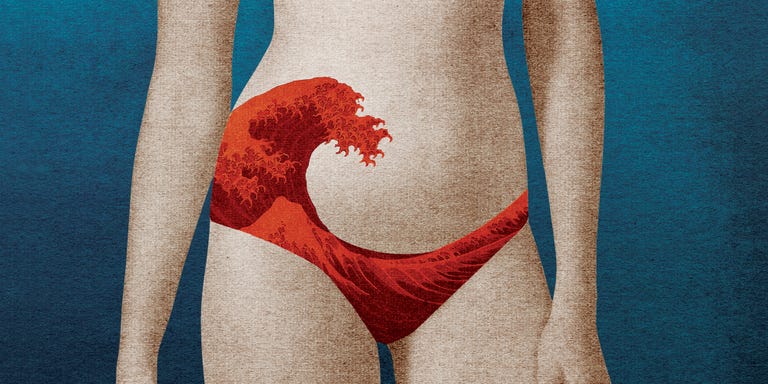
Listen, I love Ariana Grande as much as the next girl…but actually waxing poetic about “walking side to side”? Girl, are you kidding me?
I’d literally rather have any other type of pain than vaginal pain. A stubbed toe? Definitely. A cavity? Let me keep tonguing that molar. But please, pain, stay away from my entire vaginal area.
Unfortunately, you don’t get to pick and choose your pain. But you can at least know what might be causing it—which will make finding a remedy for it so much easier.
Here’s what may be behind that always-unpleasant vaginal pain—although definitely don’t self-diagnose that ish; see your doc to figure out which cause is to blame.
1. Yeast infections
So, the most common symptoms of yeast infections are more on the itching and burning side of things, says Anil—but they can also be painful (not to mention annoying as hell). “The yeast can impact the inside of the vagina, or directly outside of the vagina, which may cause swelling and redness,” says Anil.
While you can treat a yeast infection with OTC medications (and may choose to if you’ve experienced this type of infection before), it’s best to seek a doctor’s opinion if this is your first time dealing with the condition. Your ob-gyn will perform a pelvic exam and prescribe you an anti-fungal cream to use until your symptoms are gone. And if you do decide to go the OTC route, make sure to see a doctor if your symptoms don’t clear up in a week.
2. Sexually transmitted infections
Herpes, chlamydia, gonorrhea—any kind of sexually transmitted infection (STI) can cause pain down there, says Gokhan Anil, M.D., an ob-gyn in the Mayo Clinic Health System.
For herpes specifically—which affects about one in every six Americans according to the Centers for Disease Control and Prevention, by the way—it’s typically nerve- or inflammation-related, says Anil. “Herpes tends to have specific lesions you can see and are quite tender to the touch,” he adds.
Pain from other STIs typically comes from general inflammation. “They tend to create more swelling of the vaginal tissue, which tends to be sensitive to pain and discomfort, as well as burning and itching,” says Anil.
Either way, you need a doc to check you out if you’re experiencing pain and inflammation of any kind, in order to get things under control. Chlamydia, gonorrhea, and other STIs can typically be cleared up with medication. While herpes, though not curable, can be managed to reduce outbreaks and pain.
3. Vaginal dryness
Vaginal dryness is all about estrogen—specifically a lack of it. (FYI: It’s not just for post-menopausal women, either.)
“At the end of the day, estrogen itself is a growth hormone that improves blood flow to the vagina, thickness of the vaginal wall, as well as the elasticity and lubrication of the vagina,” says Anil. And when there’s not enough estrogen coursing through your body—whether it’s from your birth control pills, breastfeeding, or, yes, menopause—it can make things pretty painful.
If you feel like your va-jay-jay doesn’t lubricate the way it used to, it might be time to check in with your doctor, says Anil. They’ll be able to treat you with something topical, or even change your contraception method, to make you a bit more comfortable.
4. Your partner’s penis
While you may be inclined to blame your own anatomy, you might want to look at your partner, too. “Is it really pain in your vagina that you’re experiencing, or is it pain during penetration—something you feel inside your belly?” says Mary Jane Minkin, M.D., an ob-gyn and founder of MadameOvary.com. “It can be very hard to differentiate.”
Basically, well-endowed men can be, er, difficult to take in—and that “belly pain” might actually be coming from a larger-than-average penis hitting your cervix (ouch!).
If sex us uncomfortable for you—and you suspect your partner’s size is to blame—try changing positions, specifically ones that don’t allow for super-deep penetration, like the reverse cowgirl. And make sure to use lube…lots of lube.
5. Vulvodynia
Vulvodynia is chronic vaginal pain without an identifiable cause (so, not because of an infection or other medical condition), according to the American College of Obstetricians and Gynecologists (ACOG). “About nine percent of women will have this kind of pain in their lives,” says Minkin, describing the discomfort as occurring during penetration or even when you’re inserting a tampon.
For some women, though, pangs of pain are spontaneous and unrelated to sex or touching the area in any way. “It’s mysterious in that it can come and go,” says Minkin.
Vulvodynia isn’t well understood, but doctors believe the pain comes from the extra nerve fibers in that outer part of the vagina and vulva. “It’s the most enervated part of the vagina,” says Anil. Doctors who diagnose vulvodynia will often treat it with topical medications such as lidocaine, which are also used for fibromyalgia, another chronic pain condition without a known cause.
6. Endometriosis or pelvic inflammatory disease
Endometriosis is kind of a confusing condition—and pretty tricky for doctors to diagnose, too. Endometriosis is when your endometrial tissue (a.k.a, the innermost lining of your uterus) grows in places outside of the uterus (like inside your pelvic region, your abdomen, or even other places, like your lungs).
The condition is also incredibly painful. “It creates chronic inflammation and scarring around tissues, which can cause pain,” says Anil.
Pelvic inflammatory disease—an infection of your uterus, fallopian tubes, or ovaries—is another inflammatory condition that can cause pain in your vagina. “It can result in scarring inside the pelvic organs, or it may cause [the pelvic organs] to attach to one another, causing chronic discomfort and pain,” says Anil.
After a pelvic exam and ultrasound to determine whether you’re suffering from one of these conditions, your doctor will likely put you on a course of painkillers and hormone therapy.
Source: Read Full Article